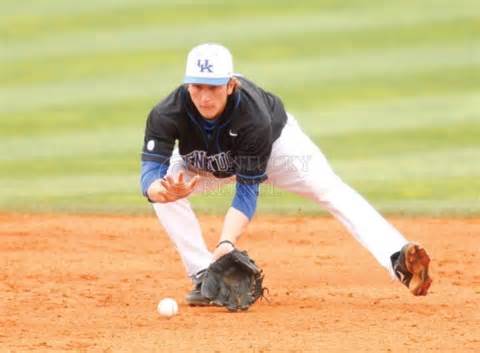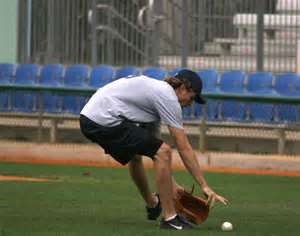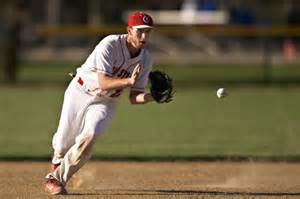Third Base Basics
Talking third base basics can encompass many, many things, so I’ll attempt to begin with the very basics as I see them. The third baseman normally positions himself 10 to 15 feet off the right field foul line and 10 to 12 feet behind the third base bag. Considering there is 90 feet of left side infield to cover, it doesn’t seem he’s positioned correctly. He is and here’s why.
The Third base position is nick named the Hot Spot or Hot Corner because in comparison to other infielders, you’re very close to the hitter. A right handed power hitter pulling an inside pitch, will hit bullets towards you, and left handed power hitters going the other way will show no mercy. Because these types of hits will be traveling extremely fast and will be tailing, the fielder is limited from covering any substantial amount of territory before the ball is passed him.
Third Base Basics - Great Fielding Position

Instant reflexes are essential for playing the third base position, as a certain amount of balls you will field will be performed more from instinct and reflex because the ball is moving so fast, you won’t have time to think.
Although you don’t have to be fast, that is fleet of foot, you must have quick feet, and have the ability to move 3 to 4 feet incredibly fast. If you notice a large portion of MLB third basemen are players who posses a good quick glove, a big or power bat, but be of average speed as a runner, if not below average, as a fast third baseman is just icing on the cake.
It shouldn’t have to be repeated, but because of its importance I will, it’s very important the fielder be in a proper fielding position of knees bent, glove down, head up and moving as the pitcher goes into his windup.
As stated before, many catches you’ll make will be purely reactive, that is you won’t have time to think about what to do, you just do it. If you’re not in proper fielding position when the ball is hit, there won’t be time to adjust.
So third base basics number #1 is proper positioning and fielding position.
Clickbank Products
All infielders, outfielders too, should always be of the mindset they want every ball hit to him, but sometimes a third baseman concentrates too much on fielding balls to his right, because they will result in an extra bases hit, and fielding the ball backhanded can be difficult. However, always be of the mindset “I’ll field every ball hit to the left side of the infield no matter where it’s hit.”
This is not just a motto or mindset, there is concrete proof by fielding any ground ball you can reach to your left, you’ve reduced the batter’s chance of reaching first base safely. How?
By cutting in front of the shortstop and fielding the ball you have gotten to the ball much quicker than the shortstop. Remember if the ball is moving slow enough for you to travel any significant distance to catch it, it will obviously be traveling slower and taking longer to reach the shortstop, even if he’s charging the ball.
Third Base Basics - Stay Low

By moving to your left to intercept the ball you are moving towards the right side of the infield, actually in some cases, running directly towards first base making the throw shorter and easier than trying to throw across your body. Third Base Basics number #2 … field everything you can to your left.
We’ve talked about the difficulty of fielding screaming ground balls, envisioning little B.B’s hitting around and passed us, but ironically fielding a bunt, especially a swinging bunt, is one of the harder plays a 3rd baseman will have to make.
(a.) In an anticipated bunt situation, such as a sacrifice bunt, as soon as the hitter takes the bat off his shoulders and begins to square around to bunt, you should be charging towards the plate. Don’t worry about what the pitcher is doing or where he is in his delivery, watch the batter.
(b.) It’s Imperative you Stay Low, because the ball will be on the ground, and if the ball is popped up into the air rising to catch it will be no problem. Your first intention in a sacrifice bunt situation, is to field the ball and throw to second base in order to force the lead runner out, which is always a bang - bang play. If you are not already low when you reach the ball and need the time to get low then rise before throwing, chances of throwing the lead runner out is zero, unless he falls down before reaching the base.

Third Base Basics - Attack Baseball
(c.) A swinging bunt, a ball unintentionally hit softly, or a bunt intended for a hit, will require the exact same fielding method as the sacrifice bunt. Number one, you’ll probably be surprised by the hit and will be playing at your regular depth. Therefore, you won’t have time to field the ball, set then throw. You’ll have to be low, fielding the ball with your bare hand and while simultaneously moving forward, throw sidearm across your body to first base.
Third Base Basics number #3 … Attack a bunt or slow roller low.
Coaches teach players to Always try to field the ball in front of them instead from the side, and this is especially important to the third baseman. Generally most balls hit directly at the third baseman will be hit hard, therefore getting to you in a hurry. If you can knock the ball down and keep it in either in front of you or slightly to your side, 95% of the time you’ll have time to pick the ball up and still beat the runner to first with the throw because of the quickness to the ball reached you.
Double Play & Third Base Basics
When discussing Basics teaching how to turn a double play may not normally come to mind for some coaches, but because of the rarity of this play and basic simple execution, let’s learn this double play technique.
Here’s the situation, bases are loaded with less than 2 outs. The play is the infielder to home to first double play. Here’s how it works.
The coach will call one of two defensive alignments to set up this play.
(1.) One alignment is to have the third baseman and first baseman play shallow, nearly bunt defense shallow, while the middle infielders stay at double play depth.
(2.) The second alignment is to have the entire infield playing in, the left side of the infield positioned middle to shallow depth, the right side of the infield cheating in as far as possible.
The reason for the difference in playing depth is a ball hit to left side of the infield gets to the infielder quicker and his throw to home plate is shorter than that of infielders on the right side.
This intended play should not be a secret to anyone. The Catcher, who is the infield general, should loudly tell the team “Home to First Double Play.” Everyone must be on the same page.
The third baseman should have only ONE thing on his mind to perform. Once he catches the ball there is NO hesitation, he immediately throws a chest high strike to the catcher who will be standing in front of the plate, his right foot touching it.
The catcher upon receiving the throw, should take one step, or crow hop, into the infield, which gives him an unobstructed view of the first baseman, and fire a chest high strike to him.
Even in the event the double play is not successful at first base, for whatever reason, by throwing home the third baseman has assured the team of getting 1 out and stopping a run from scoring. That's third base basics at it's finest.
Third Base Basics to Infield Drills

New! Comments
Have your say about what you just read! Leave me a comment in the box below.